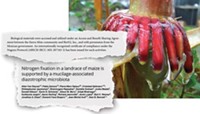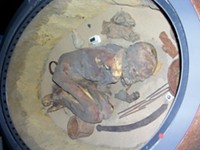Advertisement
Grab your lab coat. Let's get started
Welcome!
Welcome!
Create an account below to get 6 C&EN articles per month, receive newsletters and more - all free.
It seems this is your first time logging in online. Please enter the following information to continue.
As an ACS member you automatically get access to this site. All we need is few more details to create your reading experience.
Not you? Sign in with a different account.
Not you? Sign in with a different account.
ERROR 1
ERROR 1
ERROR 2
ERROR 2
ERROR 2
ERROR 2
ERROR 2
Password and Confirm password must match.
If you have an ACS member number, please enter it here so we can link this account to your membership. (optional)
ERROR 2
ACS values your privacy. By submitting your information, you are gaining access to C&EN and subscribing to our weekly newsletter. We use the information you provide to make your reading experience better, and we will never sell your data to third party members.
Biological Chemistry
Navigating Nagoya
Natural product hunters prepare to adapt to new biodiversity treaty
by Carmen Drahl
February 28, 2011
| A version of this story appeared in
Volume 89, Issue 9

In 1876, hapless adventurer Henry A. Wickham emerged from the depths of the Brazilian jungle with 70,000 seeds from Hevea brasiliensis, the rubber tree. The Englishman had a reputation for crafting cockamamie business schemes, but that seed collection was different. It proved to be his lone success in life, and it changed the course of history.
Within a few decades, rubber from plantation-grown trees in the Far East, scions of Wickham’s seeds, flooded the market, making the British Empire king of rubber production at a time when the resource was rare. As explained in the book “The Thief at the End of the World,” this decimated Brazil’s rubber trade, leaving the country’s economy in shambles. And Wickham’s name became synonymous with both entrepreneurial daring and imperial biopiracy.
Today, Wickham might not be able to abscond with native seeds so easily, because a network of laws now regulates researchers collecting biological materials abroad. The United Nations Convention on Biodiversity, a treaty that went into effect in 1993, was designed to ensure that a story like Wickham’s would not happen again. The treaty declared that living things are not the common property of all humankind, and that nations hold sovereign rights to the biological materials within their territory.
Last fall, environment ministers from nearly 200 nations hammered out an extension to that 1993 pact. The new agreement, called the Nagoya protocol, provides specifics on how researchers should access genetic material, small molecules, or proteins from far-flung nations. It explains how researchers should give fair compensation to biodiversity-rich nations if any molecules become drugs or otherwise prove profitable (C&EN, Dec. 6, 2010, page 34).
Researchers who travel the world to study living things and the molecules nature makes are not sure how the Nagoya protocol will affect their work. They praise the pact for clarifying where scientists should go to get clearance for collecting samples. And they say the agreement affirms or reinforces ground rules that some U.S.-based programs already follow. However, some researchers worry that new regulations might delay or stifle research.
Countries that ratify the Nagoya protocol must establish a national focal point for accessing biological materials. This focal point could be a university, government agency, or other contracting institution. This measure clarifies part of the collection process that has been murky, says University of California, San Diego, natural products researcher William H. Gerwick, who studies biologically active components of marine algae from Panama and other countries.
When collecting samples “in the old days, if we had a contact at, for example, the University of the South Pacific, that felt like we were making a good and honest effort to involve the country of origin,” Gerwick says. But the UN’s 1993 treaty changed the process by requiring that a country’s government become involved in the approval process.
“Now let’s say I want to do fieldwork in China,” Gerwick says. For a country like China, with so many agencies and authorities, figuring out where to go for permission to do research can be overwhelming, he says. “So having a unified system and a defined point of contact will be a good advance.”
A well-defined access point for researchers is a good idea, agrees David J. Newman, chief of the Natural Products Branch at the National Cancer Institute (NCI). “But I’m not sure it’s always going to work as the Nagoya agreement puts it,” he says. Several countries already have de facto access points, he explains. But many countries do not, and if a nation’s provincial or regional governments are strong, setting up one access point that all parties agree on could be challenging.
In addition to going through a national access point, the Nagoya pact requires researchers to respect indigenous peoples’ laws and customs when obtaining permission to collect samples. This measure is critical for being able to work in countries such as Fiji, where the chief and village systems are still strong, and researchers must get an okay from every village they work in on top of government agreements, says Mark E. Hay of Georgia Institute of Technology, who studies marine natural products from the island nation.
To gain a chief’s permission to do research, Hay’s team typically takes part in a small ceremony with help from local contacts. “When we show up in a village we bring kava—that’s a mildly narcotic root,” Hay explains. After presenting the kava—an ingredient in a drink—as a gift and donning a traditional sulu, which resembles a skirt, “we sit on the floor, usually on woven grass mats, do kava with the chief, and tell him what we’re doing.”
If a chief approves, the research team gets a signed agreement from him as well as verbal permission, Hay says. The signature legally protects locals’ interests and shows them that the team respects their rights, while also reassuring Fiji’s government that the proper permissions have been lined up. But at the local level, honoring customs is key, Hay adds. There, “it’s the face time and trust that’s critical.”
Hay and many other U.S.-based researchers have for years been doing what the Nagoya agreement asks, says natural products researcher D. Doel Soejarto of the University of Illinois, Chicago. The U.S. is not a party to the biodiversity convention, but it recognizes its terms and conditions and respects access systems other countries put in place, he says. Several researchers, including Hay and Soejarto, do this with help from government grant programs, such as the National Institutes of Health’s International Cooperative Biodiversity Groups program, which made its first awards in 1993, or NCI’s National Cooperative Drug Discovery Groups program, which began in 1983.
These programs have always included specific measures for repaying communities for use of their natural materials, Soejarto says. An agreement could include training for scientists, help with establishing or strengthening scientific infrastructure, or help with local economic development, on top of royalty payments, he explains.

As to whether the Nagoya pact will make their lives easier or more complicated, researchers have varied opinions. Gordon Cragg, NIH special volunteer to the NCI Natural Products Branch, believes the agreement will help because it calls for simplified access measures for noncommercial research purposes. “The real value only comes when you’ve discovered a promising lead, something you might be able to take into preclinical development, for example,” Cragg says.
But on early-stage research expeditions, a team may look at scores of biological samples, and oftentimes none of them will pan out. So it’s counterproductive to bog down early-stage agreements with negotiations on royalties, Cragg says. “You don’t know what you’re dealing with yet,” he explains. He and NCI colleague Newman both say they have long been in favor of setting up two-stage agreements, in which discussion of royalties would happen after a research team finds a promising small molecule, gene, or protein.
UCSD’s Gerwick is concerned that the Nagoya protocol will make some aspects of international research more difficult. His team dealt with a drawn-out renegotiation process for collecting specimens in Panama when a new government took power. “Long story short, that took about two years,” Gerwick says. “If we have new regulations, does that mean another two-year hiatus in our program? I’m not sure many programs, our own included, could withstand that.”
The Nagoya protocol is expected to come into effect in 2012. In the meantime, an intergovernmental committee will convene to further elaborate its guidelines.
“These things go on at more of a political level than a scientific level, and we try to adapt,” Hay says. He adds that he and his team will do whatever the Nagoya protocol asks of them. “But we’ll also continue to be nice to the chiefs.”






Join the conversation
Contact the reporter
Submit a Letter to the Editor for publication
Engage with us on Twitter